Deck 15: Aggregate Demand and Aggregate Supply
Question
Question
Question
Question
Question
Question
Question
Question
Question
Question
Question
Question

Unlock Deck
Sign up to unlock the cards in this deck!
Unlock Deck
Unlock Deck
1/12
Play
Full screen (f)
Deck 15: Aggregate Demand and Aggregate Supply
1
Redraw Figure 2, showing how a decrease in the price level will lead to an increase in equilibrium real GDP.
Reference:
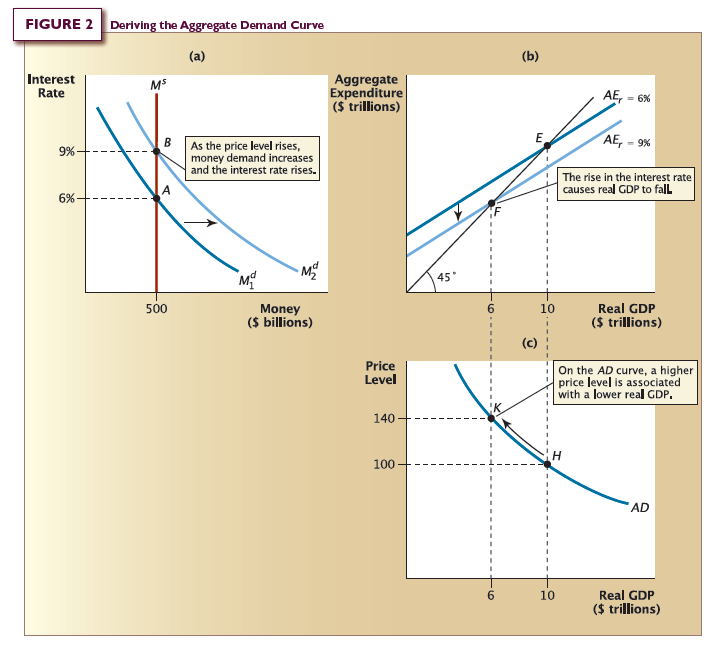
Reference:

Reduction in the price level causes an increase in the aggregate demand. As the price level declines, the demand for money also falls down which again leads to a reduction in the rate of interest.
Reduction in the rate of interest causes an increase the investment spending. Investment spending is a component of aggregate demand. The following is a figure which shows the price level and changes in the real GDP.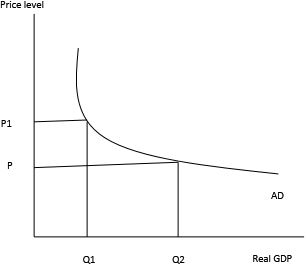
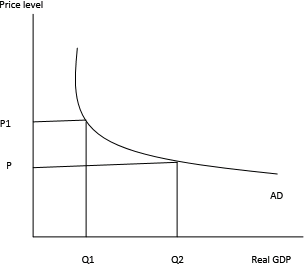 The above figure indicates that decline in price level causes an increase in the real GDP. As indicated in the figure, the real GDP increases from Q1 to Q2 due to fall in the price level.
The above figure indicates that decline in price level causes an increase in the real GDP. As indicated in the figure, the real GDP increases from Q1 to Q2 due to fall in the price level.
Reduction in the rate of interest causes an increase the investment spending. Investment spending is a component of aggregate demand. The following is a figure which shows the price level and changes in the real GDP.

 The above figure indicates that decline in price level causes an increase in the real GDP. As indicated in the figure, the real GDP increases from Q1 to Q2 due to fall in the price level.
The above figure indicates that decline in price level causes an increase in the real GDP. As indicated in the figure, the real GDP increases from Q1 to Q2 due to fall in the price level. 2
With a three-panel diagram-one panel showing the money market, one showing the aggregate expenditure diagram, and one showing the AD curve-show how a decrease in the money supply shifts the AD curve leftward.
Decrease in money supply causes an increase in the rate of interest. An increase in the rate of interest in turn negatively affects the investment spending which is a component of aggregate demand.
The following is a panel of three diagrams which shows the effects of a change in money supply on the aggregate demand.
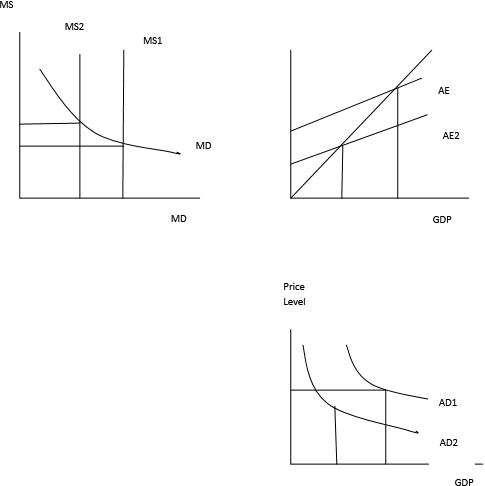 The above panel shows that a decline in money supply causes a leftward shift in the aggregate demand curve. Investment spending is negatively affected due to a rise in the interest rate. The aggregate demand tends to decline due to decrease in the investment spending.
The above panel shows that a decline in money supply causes a leftward shift in the aggregate demand curve. Investment spending is negatively affected due to a rise in the interest rate. The aggregate demand tends to decline due to decrease in the investment spending.
The following is a panel of three diagrams which shows the effects of a change in money supply on the aggregate demand.

 The above panel shows that a decline in money supply causes a leftward shift in the aggregate demand curve. Investment spending is negatively affected due to a rise in the interest rate. The aggregate demand tends to decline due to decrease in the investment spending.
The above panel shows that a decline in money supply causes a leftward shift in the aggregate demand curve. Investment spending is negatively affected due to a rise in the interest rate. The aggregate demand tends to decline due to decrease in the investment spending. 3
Suppose firms become pessimistic about the future and consequently investment spending falls. With an AD and AS graph, describe the short-run effects on real GDP and the price level. If the AS curve was a horizontal line, how would your answer change?
If firms become pessimistic about future, then they are likely to reduce investment spending. A reduction in the investment spending causes a decline in the real GDP. The following is a graphical representation of the short run effects on real GDP. 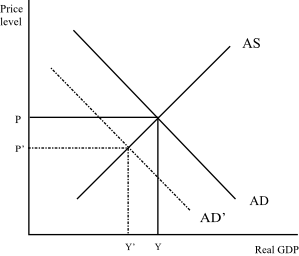 A fall in investment spending by firms leads to a shift in the AD curve towards the left. This in turn shifts the equilibrium to a lower point, thus leading to a fall in the price as well as real GDP of the economy.
A fall in investment spending by firms leads to a shift in the AD curve towards the left. This in turn shifts the equilibrium to a lower point, thus leading to a fall in the price as well as real GDP of the economy.
If the AS curve is horizontal then there would BE a fall in the real GDP with no change in the price level. Such a change negatively affects the growth and development of the economy.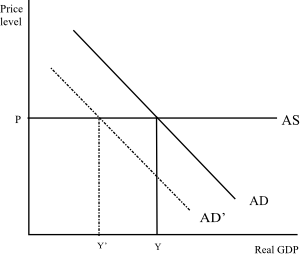
 A fall in investment spending by firms leads to a shift in the AD curve towards the left. This in turn shifts the equilibrium to a lower point, thus leading to a fall in the price as well as real GDP of the economy.
A fall in investment spending by firms leads to a shift in the AD curve towards the left. This in turn shifts the equilibrium to a lower point, thus leading to a fall in the price as well as real GDP of the economy.If the AS curve is horizontal then there would BE a fall in the real GDP with no change in the price level. Such a change negatively affects the growth and development of the economy.

4
With an AD and AS diagram only, explain the short run and long-run effects of a decrease in the money supply on real GDP and the price level. Assume the economy begins at full employment.

Unlock Deck
Unlock for access to all 12 flashcards in this deck.
Unlock Deck
k this deck
5
Use an AD and AS graph to explain the short-run and long-run effects on real GDP and the price level of an increase in autonomous consumption spending. Assume the economy begins at full employment.

Unlock Deck
Unlock for access to all 12 flashcards in this deck.
Unlock Deck
k this deck
6
A new government policy successfully lowers firms' unit costs. What are the short-run and the long-run effects of such a policy? (Assume that full employment output does not change.)

Unlock Deck
Unlock for access to all 12 flashcards in this deck.
Unlock Deck
k this deck
7
In 1991, the Fed lowered its interest rate target, helping to bring the recession of that year to a rapid end. Make two copies of Figure 14(a) on a sheet of paper. Add curves to illustrate your answer to question (a) on one copy and question (b) on the other:
a. What would have happened in the years after 1991 if the Fed had done nothing and the economy had relied solely on the self-correcting mechanism to return to full employment?
b. What did happen as a result of the Fed bringing down the interest rate to end the recession?
c. Is there a difference in the behavior of the price level during the recovery in these two cases? Explain.
Reference:
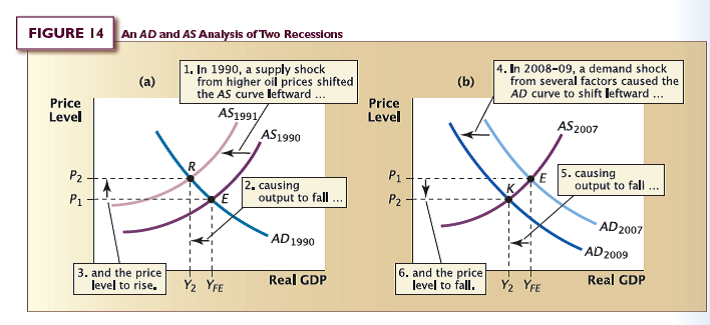
a. What would have happened in the years after 1991 if the Fed had done nothing and the economy had relied solely on the self-correcting mechanism to return to full employment?
b. What did happen as a result of the Fed bringing down the interest rate to end the recession?
c. Is there a difference in the behavior of the price level during the recovery in these two cases? Explain.
Reference:


Unlock Deck
Unlock for access to all 12 flashcards in this deck.
Unlock Deck
k this deck
8
What would happen to the AD curve if both government purchases and net taxes were increased by the same amount? [Hint: Review the balanced budget multiplier in the fiscal policy chapter.]

Unlock Deck
Unlock for access to all 12 flashcards in this deck.
Unlock Deck
k this deck
9
Increased international trade has forced many U.S. firms to compete with foreign producers. The increased competition has likely affected the average markup in the U.S. economy. (How?) Use AS and AD curves to illustrate the short-run impact on the economy if, at the same time,
a. The Fed does nothing.
b. The Fed pursues a policy that successfully achieves the highest possible level of GDP with no rise in the price level.
a. The Fed does nothing.
b. The Fed pursues a policy that successfully achieves the highest possible level of GDP with no rise in the price level.

Unlock Deck
Unlock for access to all 12 flashcards in this deck.
Unlock Deck
k this deck
10
Using AD and AS curves:
a. Graphically show the effects of a temporary decrease in nonlabor input prices.
b. How will your results change if this decrease lasts for an extended period?
c. How would your results differ if the Fed intervened to keep the economy at full employment?
a. Graphically show the effects of a temporary decrease in nonlabor input prices.
b. How will your results change if this decrease lasts for an extended period?
c. How would your results differ if the Fed intervened to keep the economy at full employment?

Unlock Deck
Unlock for access to all 12 flashcards in this deck.
Unlock Deck
k this deck
11
Suppose that wages are slow to adjust downward but rapidly adjust upward. What would the AS curve look like? How would this affect the economy's adjustment to demand shocks (compared to the analysis given in the chapter)?

Unlock Deck
Unlock for access to all 12 flashcards in this deck.
Unlock Deck
k this deck
12
During the 1990s, because of technological change, the AS curve was shifting downward, but-except for a few months-the price level did not fall. Why not? (Hint: What might the Fed have been doing as the economy's potential output and actual output grew?)

Unlock Deck
Unlock for access to all 12 flashcards in this deck.
Unlock Deck
k this deck



